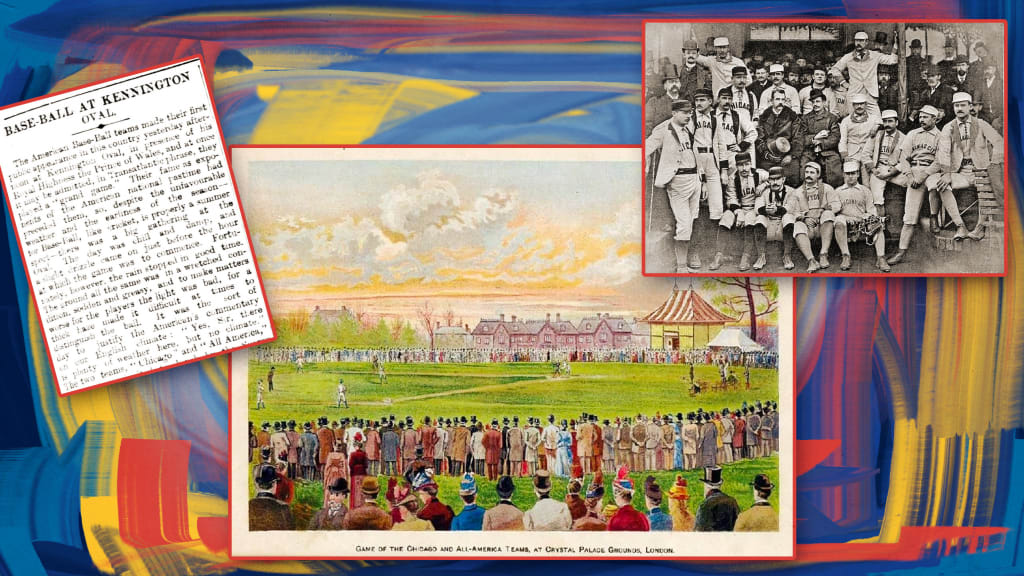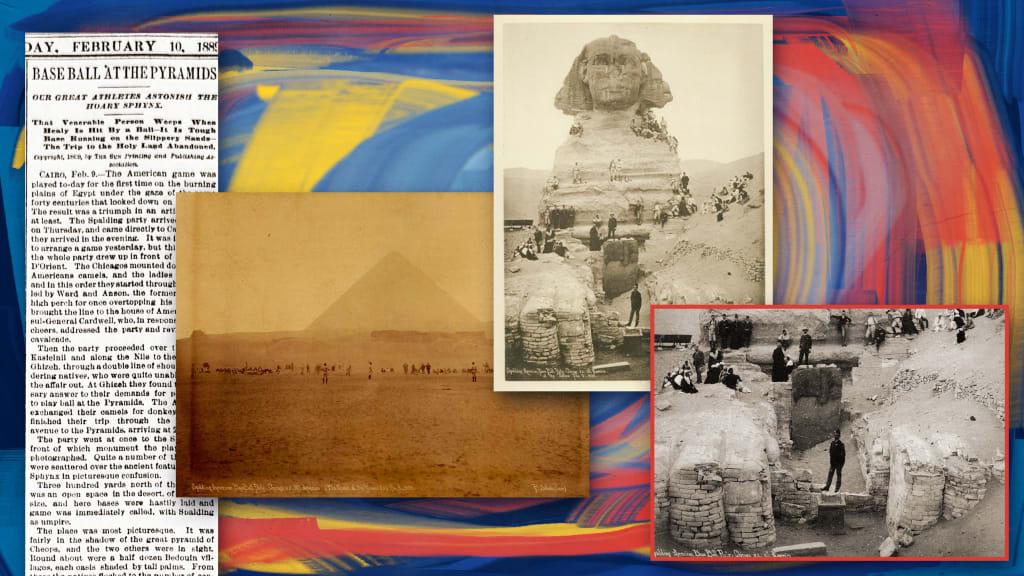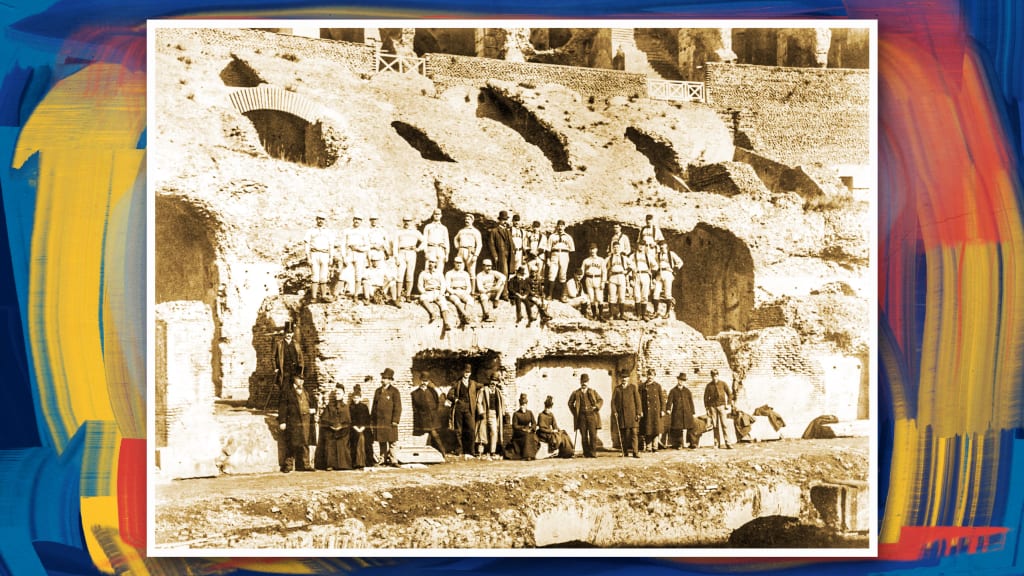
CHICAGO -- The trip across the English Channel was, by all accounts, a harrowing one. A storm whipped at the sides of the vessel carrying players from Chicago’s ballclub and a group of stars from around baseball. After traversing the globe, it was this short journey that created the most angst.
“Men, women and children were huddled together in the first cabin,” Chicago outfielder Jimmy Ryan penned in his diary on March 9, 1889. “Some singing, some joking, but the greater majority, praying.”
When the modern-day Cubs and Cardinals travel to England this weekend for the London Series -- showing off baseball at London Stadium -- the circumstances will be much different than the late 19th century. It will be a five-day trek in all for travel, sight-seeing, community stops, games and then back to business in the States.
The trip that owner Albert Spalding pulled off with his Chicago White Stockings club (known now as the Cubs) in the winter of 1888-89 was nothing short of remarkable. It was a 30,000-plus mile voyage that took players across the United States and over oceans, bringing baseball to Australia, Asia, Africa and Europe and back home in time for Opening Day.
There was a game in the shadow of the pyramids in Egypt. The players took a photo on the steps inside the Colosseum in Rome. The Prince of Wales attended a game at Kennington Oval cricket ground in London with an estimated 8,000 fans in attendance. Players made a stop in Ireland to kiss the Blarney Stone. They arrived to a hero’s welcome in New York, where Mark Twain and Teddy Roosevelt were among the speakers at a celebratory banquet.

And it started with a bit of craftiness on the part of Spalding.
“Spalding already had these ideas in mind to do an around-the-world tour,” Cubs historian Ed Hartig said. “But it was originally billed as just Australia.”
Spalding -- a former player for Boston and Chicago -- was a skilled promoter and organizer, and he had designs on expanding his growing sporting goods empire globally. A group of Chicago’s players -- led by Hall of Famer Cap Anson -- signed in August of 1888 for the following campaign. Spalding then went to work recruiting other stars from other clubs.
When it was time to begin a barnstorming tour across the States, Spalding had enough players on board to feature Chicago’s squad against a group dubbed the All-America team. Before embarking on their six-month adventure, Spalding organized a trip to the White House to get the blessing of President Grover Cleveland.
“At this point in time,” Hartig said, “Chicago and St. Louis were quote-unquote the West Coast as far as baseball goes. No one in Iowa had seen a Major League game.”
Iowa? That was only the beginning.
Following more stops through Minnesota, Nebraska, Colorado, Utah and California, the clubs boarded a ship in San Francisco headed to the Sandwich Islands (Hawaii). They landed on Nov. 25, 1888, which was a Sunday. Due to the “blue laws” of the island, no game was permitted on that day of rest. The players were instead guests of a lavish luau.
The first games played between the “Chicagos” and “All-Americas” took place in New Zealand and Australia, where the clubs stayed through Christmas and rang in the New Year. Meanwhile, Spalding already had a business partner and promoter, Leigh Lynch, traveling ahead to make plans for games in other countries.

Through their travels, Spalding began planting the idea among players that the group could just keep going. His expertly timed conversations created a situation where the players eventually came to him, asking if there was a chance to continue the journey beyond Australia.
“It became the players’ idea to go around the world,” Hartig said with a chuckle. “But by this point, Spalding had already made arrangements to play in Europe.”
There was a stop in Ceylon (Sri Lanka) in late January before the clubs made their way to Egypt. The players and traveling party made their way to the playing site on camelback and climbed onto the Sphinx for a photo. They then set up a makeshift field with the pyramids in the distance and John Healy -- a pitcher from the National League’s Indianapolis team -- faced Chicago.
Healy was from Cairo, Ill., leading to a nickname that lasted beyond the world tour.
“When you read about the tour, they call him John,” Hartig said. “But when they get close to Egypt, all of a sudden, he’s ‘The Egyptian.’”
The tour continued to Italy, where Spalding was attempting to play a game inside the Colosseum. A dispatch in the Chicago Tribune on Feb. 15, 1889, reported: “The government was scandalized by his suggestion of this sacrilege, and Anson’s melodious bats will not echo amid the ruins of Italy’s former greatness.”
“There was some arrogance on the part of the Americans,” Hartig said. “They also invited the Pope to come to a game and didn’t understand why the Pope wouldn’t come out.”

During the team’s trip through France, they played a game in Paris -- a few weeks before the completion of the Eiffel Tower.
From there, it was time for the stomach-churning journey across the English Channel. Newspaper accounts on March 25, 1889, quoted Anson saying: “The scene aboard the boat was too pitiable to describe. There lay those boys who had triumphed over so many valiant adversaries curled up in most undignified positions on their bunks.”
The players recovered in time to begin the last leg of their tour with games throughout England -- including stops in London, Manchester and Liverpool, among others -- as well as Scotland and Ireland. During the game at Kennington Oval, Spalding sat with the Prince of Wales, who would later become King Edward VII.
“At one point,” Hartig said, “the prince slapped Spalding on the knee and said something like, ‘Oh, good cracker,’ after a hit. And then later, Spalding slaps him on the back. You don’t touch a prince. What are you doing touching a prince?”
When it was all said and done, the teams had played more than 50 games, including a handful of cricket matches and one game of rounders (with a local Liverpool team prevailing). After homecoming celebrations in New York and Chicago, the teams played their final game on April 20, 1889. Opening Day was four days later.
After the final contest, Ryan wrote in his diary: “The game concluded and so did the greatest trip in the annals of sport.”
